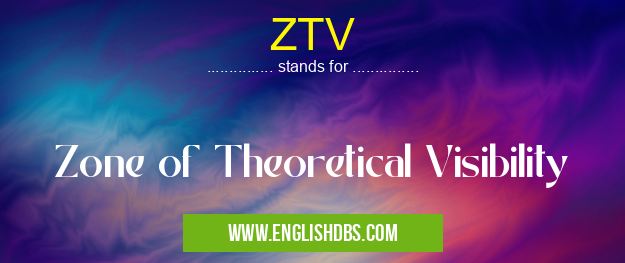What does ZTV mean in UNCLASSIFIED
ZTV stands for Zone of Theoretical Visibility. It refers to the geographical area from where a particular point or structure can be seen without obstruction. ZTV analysis is a technique used in urban planning, architecture, and telecommunications to determine the visibility of buildings, towers, and other structures.

ZTV meaning in Unclassified in Miscellaneous
ZTV mostly used in an acronym Unclassified in Category Miscellaneous that means Zone of Theoretical Visibility
Shorthand: ZTV,
Full Form: Zone of Theoretical Visibility
For more information of "Zone of Theoretical Visibility", see the section below.
What is ZTV?
ZTV analysis involves creating a 3D model of the surrounding environment and calculating the areas that are visible from a specific vantage point. This analysis considers factors such as terrain, buildings, vegetation, and other obstacles that may block the view.
How is ZTV Calculated?
ZTV is calculated using a process called line-of-sight analysis. This involves drawing a series of lines from the vantage point to each point in the surrounding area. If a line of sight is clear, the point is considered visible. If the line of sight is obstructed by an obstacle, the point is considered not visible.
Applications of ZTV
ZTV analysis has various applications, including:
- Urban planning: Assessing the visibility of proposed buildings and structures to ensure they do not obstruct views or create visual clutter.
- Architecture: Designing buildings with optimal visibility for natural light and views.
- Telecommunications: Determining the placement of cell towers and other communication infrastructure to ensure adequate signal coverage.
- Environmental planning: Assessing the visual impact of development projects on scenic areas and natural landscapes.
Essential Questions and Answers on Zone of Theoretical Visibility in "MISCELLANEOUS»UNFILED"
What is the Zone of Theoretical Visibility (ZTV)?
The Zone of Theoretical Visibility (ZTV) is a geographical area that represents the theoretical range of visibility of a structure, such as a wind turbine or a telecommunications tower. It is a tool used to assess the potential visual impact of a proposed structure on the surrounding landscape.
How is the ZTV calculated?
ZTVs are typically calculated using computer modeling software that takes into account various factors, including the height and location of the structure, the topography of the surrounding area, and the presence of any obstacles, such as trees or buildings.
What is the purpose of a ZTV?
ZTVs are used by planners, developers, and environmental regulators to assess the potential visual impact of proposed structures. They help to identify areas that may be affected by the structure's visibility and to mitigate any potential negative impacts.
Are ZTVs always accurate?
ZTVs are based on theoretical assumptions and do not always reflect the actual visibility of a structure. Factors such as weather conditions, vegetation growth, and the presence of other structures can affect the actual visibility.
How can I use a ZTV?
ZTVs can be used to:
- Identify areas that may be affected by the visibility of a proposed structure.
- Mitigate potential negative visual impacts by adjusting the design or location of the structure.
- Communicate the visual impact of a proposed structure to stakeholders.
Final Words: ZTV analysis is a valuable tool for evaluating visibility and planning in various fields. By understanding the Zone of Theoretical Visibility, stakeholders can make informed decisions about the placement and design of structures to optimize their visibility and minimize potential visual obstructions.
